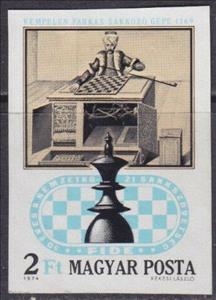Stamp: Farkas Kempelen's chess playing machine (Hungary 1974)
Farkas Kempelen's chess playing machine (Hungary 1974)
18 June (Hungary ) within release 50th Anniversary of the International Chess Federation goes into circulation Stamp Farkas Kempelen's chess playing machine face value 2 Hungarian forint
| Stamp Farkas Kempelen's chess playing machine in catalogues | |
|---|---|
| Michel: | Mi: HU 2961B |
| Philatelia Hungarica Catalog: | PHu: HU 2965V |
Stamp is vertical format.
Also in the issue 50th Anniversary of the International Chess Federation:
- Stamp - Chess Players from 15th Century Manuscript face value 40;
- Stamp - Chess Players, 15th Century, English Woodcut face value 60;
- Stamp - Royal Chess Party, 15th Century, Italian Chess Book face value 80;
- Stamp - Chess Players 17th Century Copper Engraving by Selenus face value 1.20;
- Stamp - Farkas Kempelen's chess playing machine face value 2;
- Stamp - Hungarian Grandmaster Géza Maróczy face value 4;
- Stamp - View of Nice, 1974 Chess Olimpics face value 6;
- Stamp - Chess Players 17th Century Copper Engraving by Selenus face value 1.20;
- Stamp - Chess Players from 15th Century Manuscript face value 40;
- Stamp - Chess Players, 15th Century, English Woodcut face value 60;
- Stamp - Farkas Kempelen's chess playing machine face value 2;
- Stamp - Hungarian Grandmaster Géza Maróczy face value 4;
- Stamp - Royal Chess Party, 15th Century, Italian Chess Book face value 80;
- Stamp - View of Nice, 1974 Chess Olimpics face value 6;
Stamp Farkas Kempelen's chess playing machine it reflects the thematic directions:
Chess is usually played by two players (called chess players) against each other. It is also possible for one group of chess players to play against another or against one player; such games are often called consultation games. In addition, there is the practice of simultaneous play sessions, when several opponents play against one strong player, each on a separate board.
The rules of the game were basically developed by the 15th century; In modern official tournaments, the rules of the International Chess Federation[6] are applied, which regulate not only the movement of pieces, but also the rights of the judge, the rules of behavior of players and time control. A game played remotely - for example, by correspondence, by telephone or via the Internet - has special rules. There are many variants of chess that differ from classical ones: with non-standard rules, pieces, board sizes, etc. The corresponding section of chess composition is fairy chess. Some aspects of the game of chess are studied in mathematics (for example, the classic “Knight's Move Problem” and “Eight Queens Problem”), including through computer simulation. Chess is usually played by two players (called chess players) against each other. It is also possible for one group of chess players to play against another or against one player; such games are often called consultation games. In addition, there is the practice of simultaneous play sessions, when several opponents play against one strong player, each on a separate board.
The rules of the game were basically developed by the 15th century; In modern official tournaments, the rules of the International Chess Federation[6] are applied, which regulate not only the movement of pieces, but also the rights of the judge, the rules of behavior of players and time control. A game played remotely - for example, by correspondence, by telephone or via the Internet - has special rules. There are many variants of chess that differ from classical ones: with non-standard rules, pieces, board sizes, etc. The corresponding section of chess composition is fairy chess. Some aspects of the game of chess are studied in mathematics (for example, the classic “Knight's Move Problem” and “Eight Queens Problem”), including through computer simulation.
Sport is a form of physical activity or game. Often competitive and organized, sports use, maintain, or improve physical ability and skills. They also provide enjoyment to participants and, in some cases, entertainment to spectators. Many sports exist, with different participant numbers, some are done by a single person with others being done by hundreds. Most sports take place either in teams or competing as individuals. Some sports allow a "tie" or "draw", in which there is no single winner; others provide tie-breaking methods to ensure one winner. A number of contests may be arranged in a tournament format, producing a champion. Many sports leagues make an annual champion by arranging games in a regular sports season, followed in some cases by playoffs.


